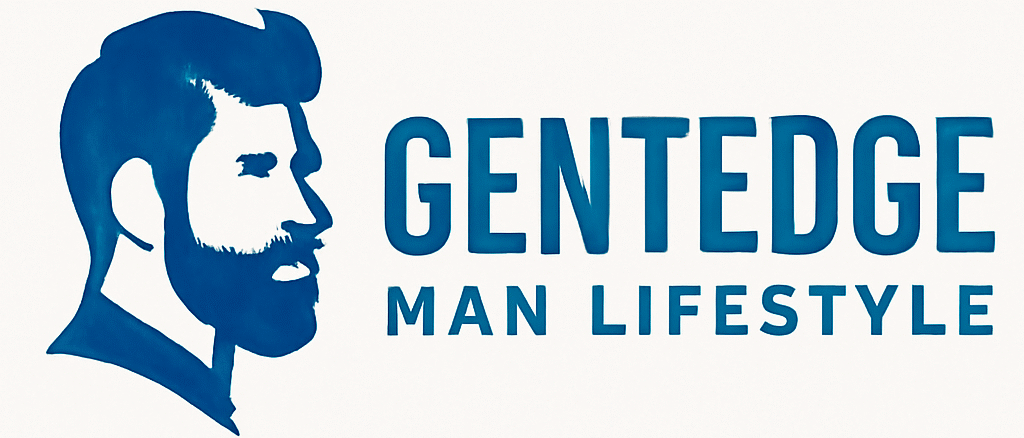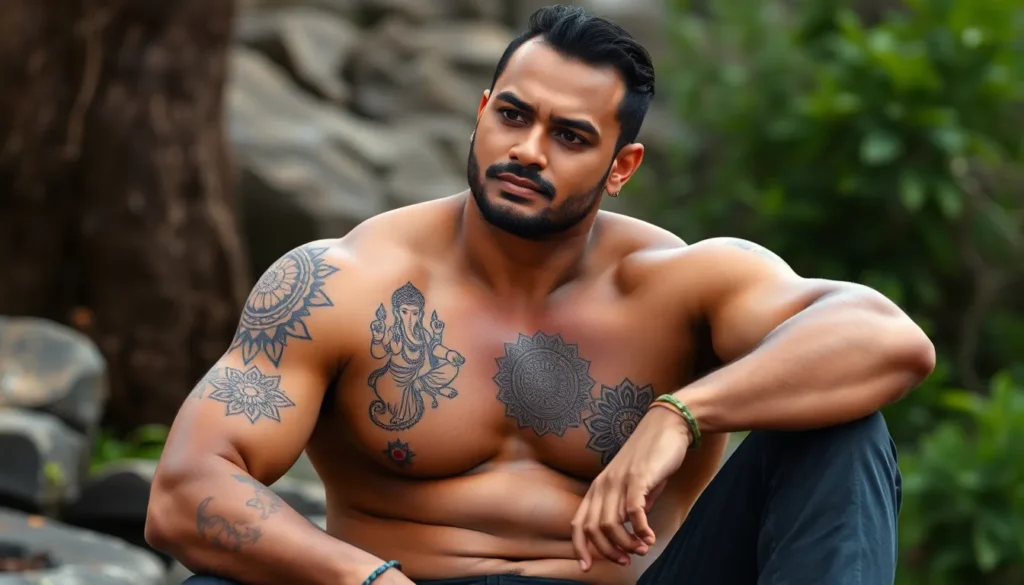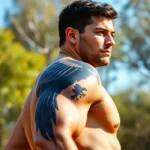Indian tattoo designs for men have exploded in popularity across the globe and it’s easy to see why. These powerful symbols carry centuries of cultural significance while delivering the bold aesthetic that modern men crave. From intricate mandala patterns to fierce warrior imagery we’re seeing more guys embrace these meaningful designs that tell stories beyond skin deep.
What makes Indian tattoos so compelling is their perfect blend of spiritual symbolism and masculine appeal. Whether you’re drawn to the protective energy of Hindu deities the geometric precision of sacred patterns or the raw power of tribal motifs these designs offer something for every personality and style preference.
We’ve compiled the most striking Indian tattoo designs that resonate with men today. These aren’t just random patterns – they’re carefully chosen symbols that represent strength wisdom protection and personal transformation. Ready to discover which ancient design speaks to your modern soul?
Traditional Hindu Deity Tattoos That Command Respect
Hindu deity tattoos represent some of the most revered and spiritually important designs in Indian tattoo culture. These sacred symbols carry deep religious meaning while creating visually stunning body art that demands respect and admiration.
Lord Ganesha Designs for New Beginnings
Ganesha tattoos symbolize the removal of obstacles and fresh starts in life. We often see men choosing elaborate Ganesha designs featuring the elephant-headed deity surrounded by lotus petals, geometric patterns, and Sanskrit mantras. Popular placements include the chest, back, and upper arm where the intricate details can be fully appreciated.
Traditional Ganesha tattoos incorporate exact symbolic elements that enhance their spiritual power. The broken tusk represents sacrifice and wisdom, while the modak (sweet) in his hand symbolizes the rewards of spiritual practice. Many men opt for realistic portraits showing Ganesha in meditation pose, while others prefer stylized versions with bold linework and traditional Indian art influences.
Modern Ganesha tattoo variations blend contemporary artistry with ancient symbolism. Watercolor backgrounds, mandala borders, and geometric frames create striking visual contrasts that make these designs stand out. We recommend consulting with artists experienced in Hindu iconography to ensure proper representation and cultural sensitivity.
Shiva and Trishul Tattoos for Strength
Lord Shiva tattoos embody destruction, transformation, and ultimate masculine power. The destroyer aspect of the Hindu trinity appeals to men seeking tattoos that represent overcoming challenges and personal transformation. Popular Shiva imagery includes the dancing Nataraja pose, the meditative third eye, and the powerful trident (trishul) symbol.
Trishul tattoos alone make powerful statement pieces representing Shiva’s authority over the three worlds. We see men placing these designs on forearms, shoulders, and calves where the vertical lines create dramatic visual impact. The three prongs symbolize creation, preservation, and destruction, while the central spear represents piercing through ignorance.
Detailed Shiva portraits showcase artistic mastery while honoring the deity’s fierce nature. Blue-skinned depictions with flowing hair, serpents around the neck, and the crescent moon create complex compositions that require skilled tattoo artists. These large-scale pieces work best on the back, chest, or as full sleeve designs.
Hanuman Tattoos for Courage and Devotion
Hanuman tattoos represent unwavering devotion, incredible strength, and protection from evil forces. The monkey deity’s legendary loyalty to Lord Rama makes these designs popular among men who value faithfulness and courage. We often see Hanuman depicted carrying mountains, wielding his mace, or in prayer poses showing his devotional nature.
Flying Hanuman designs capture the deity’s supernatural abilities and ever-changing energy. These action poses work exceptionally well as large back pieces or chest tattoos where the movement can be fully expressed. Artists typically include wind effects, flowing fabric, and mountainous backgrounds to emphasize Hanuman’s legendary leap across the ocean.
Hanuman face tattoos focus on the deity’s fierce protective qualities and spiritual wisdom. Close-up portraits highlighting his determined expression, prominent fangs, and intense eyes create powerful focal points. Many men choose to add the Hanuman Chalisa verses or “Jai Hanuman” text to enhance the spiritual significance of their tattoos.
Sanskrit and Mantra Tattoos for Spiritual Connection

Sanskrit tattoos represent the ultimate fusion of spiritual depth and masculine artistry for men seeking meaningful ink. Ancient Sanskrit language serves as the foundation for these powerful designs that connect wearers to Hindu philosophy and meditation practices.
Om Symbol Variations and Placements
Om tattoos transform the primordial sound of the universe into stunning visual art. Simple outline versions offer minimalist elegance, while intricate mandala designs incorporating Om create complex spiritual masterpieces. Men often choose finger placements for subtle daily reminders or wrist locations for easy visibility during meditation.
Chest placements maximize the Om symbol’s impact and personal significance. These larger canvas areas allow for detailed artistic interpretations that blend traditional symbolism with contemporary design elements. Om variations range from basic script forms to elaborate geometric patterns that symbolize spiritual awakening and divine consciousness.
Creative interpretations include Om symbols merged with lotus flowers or sacred geometry. These combinations amplify the spiritual meaning while creating visually striking tattoos that stand out. Many men appreciate how Om tattoos serve as constant reminders of peace and spiritual connection throughout their daily lives.
Sacred Mantras and Their Meanings
“Har Har Mahadev” tattoos channel the raw power and devotion associated with Lord Shiva. This sacred chant represents transformation and masculine divine energy, making it particularly appealing to men seeking spiritual armor. Experienced Hindu tattoo artists ensure proper Sanskrit script accuracy and cultural respect when creating these meaningful designs.
“Om Namah Shivaya” mantras embody protection and spiritual awakening through their powerful vibrations. Men choose this five-syllable mantra for its ability to serve as both meditation aid and spiritual protection. These tattoo designs often incorporate Shiva symbols like the trishul (trident) to enhance their protective qualities.
Shiva-related chants represent strength, regeneration, and spiritual transformation. Lord Shiva tattoos featuring his visage or sacred symbols create powerful masculine expressions of devotion. These mantras act as constant spiritual companions that inspire inner strength and connection to divine consciousness.
Sanskrit Quotes for Personal Inspiration
Dharma-focused quotes inspire men to embrace their life’s purpose and moral duty. Sanskrit script lends elegant and timeless visual appeal to these meaningful phrases that guide personal transformation. Popular dharma quotes emphasize righteous living and spiritual responsibility in beautifully crafted ancient text.
Karma-related Sanskrit phrases remind wearers of action and consequence principles. These inspirational quotes often feature lotus symbolism representing purity and enlightenment alongside the meaningful text. Men appreciate how these tattoos serve as daily motivation for mindful living and spiritual growth.
Moksha quotes celebrate liberation and spiritual freedom through Sanskrit wisdom. These profound statements about enlightenment and release from worldly attachments create powerful personal mantras. Sanskrit script transforms these philosophical concepts into visually distinctive tattoos that inspire lifelong spiritual journeys and inner strength development.
Mandala and Geometric Indian Patterns

Mandala tattoos represent the universe through symmetrical geometric shapes that resonate deeply with men seeking spiritual balance. We find these designs particularly compelling because they combine visual precision with profound spiritual meaning.
Traditional Mandala Designs for Balance
Traditional mandalas create cosmic harmony through carefully arranged circles, squares, and repeating patterns that symbolize unity in life. Men choose these intricate designs to represent personal equilibrium and mental clarity, with each layer reflecting the complexity of universal connection. We see the geometric precision of mandala tattoos making them visually striking while maintaining their spiritual significance in Indian culture.
The detailed layering within each mandala pattern tells a story of individual growth and cosmic awareness. Artists often incorporate traditional motifs that have been passed down through generations, ensuring authentic cultural representation. We notice that these balanced designs serve as constant reminders of inner peace and harmony for the wearer.
Yantra Symbols for Spiritual Protection
Yantras function as mystical diagrams that focus spiritual energy while offering protection from negative influences. These powerful symbols feature intersecting geometric shapes like triangles and lotus petals arranged in precise patterns that act as meditative aids. We find that men gravitate toward yantra tattoos because they’re believed to shield the wearer from harmful energies while improving concentration.
The geometric complexity of yantra designs creates a visual meditation tool that carries deep spiritual significance. Each triangle, circle, and intersection serves a exact purpose in channeling protective energy and maintaining spiritual awareness. We observe that these tattoos often become focal points for daily meditation and spiritual practice.
Lotus Flower Mandalas for Enlightenment
Lotus mandalas combine the purity symbolism of the sacred flower with circular mandala structures to represent spiritual awakening. Men select these designs to express their journey toward enlightenment and their ability to rise above worldly struggles. We see the lotus mandala as a powerful representation of growth, rebirth, and transformation that resonates with contemporary masculine spirituality.
The layered petals within lotus mandala designs create depth and movement that mirrors personal spiritual development. Artists often incorporate traditional color meanings and petal arrangements that enhance the tattoo’s spiritual significance. We find that these enlightenment symbols serve as daily reminders of personal growth and the continuous journey toward spiritual clarity.
Indian Wildlife and Nature-Inspired Tattoos

Nature’s most revered creatures form the foundation of India’s most powerful tattoo designs. We see these wildlife motifs capturing masculine energy while honoring the country’s deep spiritual connection to the natural industry.
Tiger Designs Representing Power
Tigers dominate Indian tattoo artistry as symbols of unmatched strength and fierce courage. Traditional motifs showcase this majestic predator through intricate linework that captures every stripe and muscle definition. Modern adaptations blend realistic portraits with geometric patterns to create striking sleeve designs and back pieces.
Masculine power flows through every element of tiger tattoo designs, from the piercing eyes to the powerful stance. We often incorporate elements like jungle foliage, Sanskrit mantras, or traditional Indian patterns to enhance the cultural significance. Popular placements include the chest, shoulder, and forearm where the tiger’s fierce expression creates maximum visual impact.
Protection and valor shine through traditional tiger motifs that feature the animal in hunting poses or roaring stances. These designs appeal to men seeking symbols of dominance and leadership qualities. Contemporary artists add watercolor effects or tribal elements to create unique interpretations while maintaining the tiger’s symbolic power.
Elephant Tattoos for Wisdom and Memory
Elephants carry profound spiritual significance in Indian culture, especially through their connection to Lord Ganesha. We celebrate these gentle giants as symbols of wisdom, memory, and unwavering loyalty in tattoo designs that range from realistic portraits to stylized interpretations.
Decorated elephant heads featuring ornate headpieces and ceremonial designs honor the festival traditions of India. These tattoos often incorporate intricate patterns reminiscent of temple art and royal processions. Men choose chest and upper arm placements to showcase the detailed craftsmanship and cultural reverence.
Spiritual significance radiates through Ganesha inspired elephant tattoos that symbolize obstacle removal and new beginnings. We see designs featuring the elephant’s trunk in blessing poses or surrounded by lotus flowers and sacred geometry. The intelligence and patience associated with elephants make these tattoos perfect for men seeking symbols of thoughtful leadership.
Memory and loyalty themes appear in family tribute tattoos where elephants represent strong bonds and protective instincts. These designs often incorporate multiple elephants in procession or mother and calf imagery to celebrate relationships and heritage.
Peacock Feather Patterns for Beauty
Peacock feather tattoos celebrate India’s national bird through stunning displays of color and intricate detail work. We showcase these patterns as symbols of beauty, grace, and spiritual pride that appeal to men appreciating artistic elegance.
Traditional motifs blend peacock feathers with floral and geometric patterns, creating comprehensive designs that cover arms, legs, and torso areas. Ethnographic studies show these combinations appearing in cultural tattooing practices where peacock imagery enhances fertility and spiritual symbolism. Modern interpretations maintain this traditional foundation while adding contemporary artistic techniques.
Aesthetic appeal reaches new heights through peacock feather sleeve designs that showcase the bird’s natural color spectrum. We create flowing compositions where individual feathers transition into larger patterns, often incorporating Hindu symbols or Sanskrit text. These tattoos attract men who value both visual beauty and cultural meaning.
Spiritual symbolism emerges through peacock feather mandalas that represent transformation and renewal. The “eyes” of peacock feathers symbolize divine watchfulness and protection in Indian traditions. Contemporary artists emphasize these spiritual elements through placement choices like the back or chest where the full design impact creates powerful visual statements.
Bollywood and Cultural Icon Tattoos
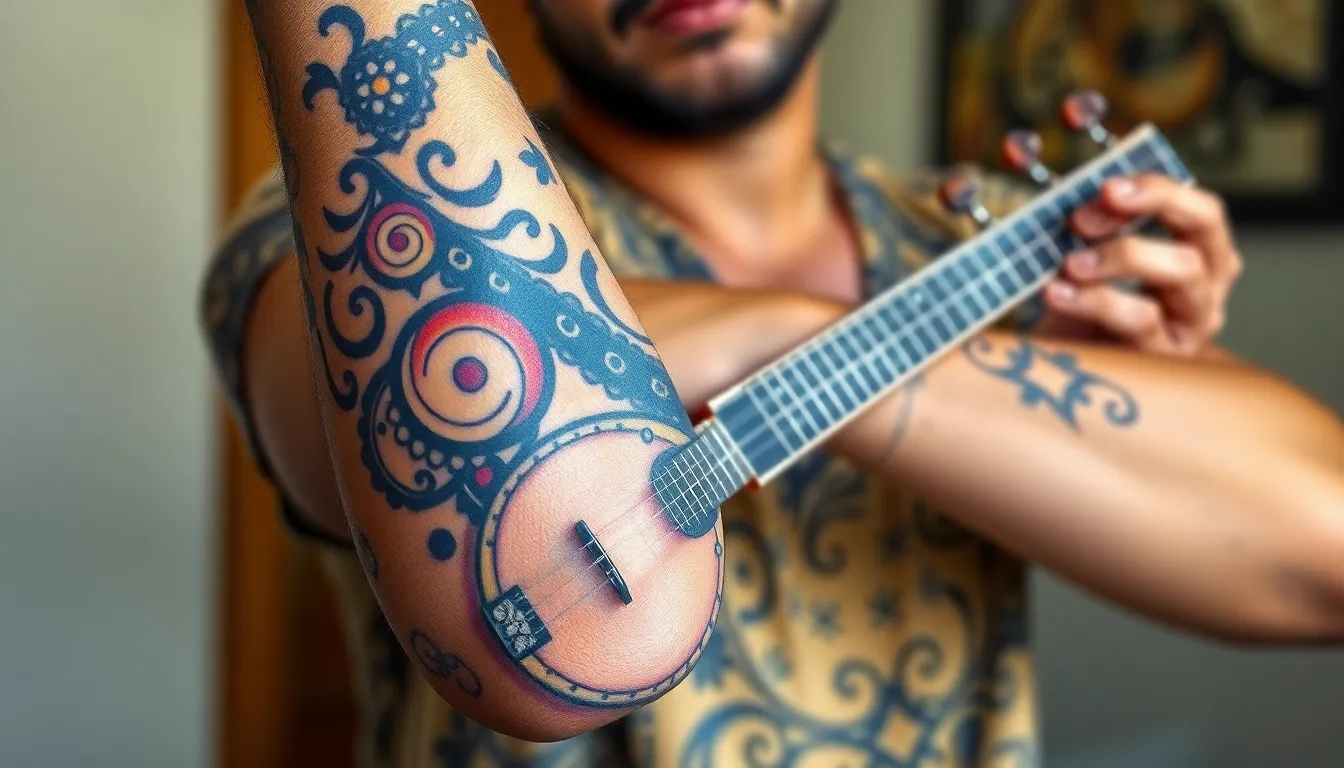
Bollywood and cultural icon tattoos represent our modern Indian identity through cinematic artistry. These designs pay tribute to India’s film heritage while showcasing personal admiration for legendary performers and iconic characters.
Movie Quote Tattoos in Devanagari Script
Movie quote tattoos in Devanagari script combine linguistic beauty with emotional storytelling. We see men choosing meaningful dialogues from their favorite films, transforming them into permanent art that celebrates both Hindi language and cinematic culture.
Devanagari script offers visual elegance that enhances the impact of powerful movie quotes. Famous lines from classic Bollywood films become personal mantras when inked in this traditional script. Popular placements include the forearm and ribcage where the flowing letters create striking visual statements.
Men often select quotes that reflect their life philosophy or memorable moments from beloved characters. Sanskrit phrases mixed with Hindi dialogues create unique combinations that honor both ancient wisdom and contemporary cinema. These tattoos serve as daily reminders of inspiration drawn from India’s rich film tradition.
Musical Instrument Designs Like Sitar and Tabla
Musical instrument tattoos like sitar and tabla celebrate India’s classical music heritage through detailed artistic representations. We find these designs particularly meaningful for men who connect with the rhythm and harmony that define Indian musical culture.
Sitar tattoos showcase the instrument’s elegant curves and intricate fretwork in both realistic and stylized interpretations. Detailed representations capture the sitar’s ornate patterns while simplified silhouettes emphasize its graceful form. These designs often incorporate decorative elements that enhance the instrument’s cultural significance.
Tabla tattoos symbolize the heartbeat of Indian classical music through their distinctive drum shapes. Artists frequently render tabla pairs with ornate patterns that reflect traditional craftsmanship. Popular variations include geometric designs surrounding the drums or musical notes flowing from the instruments.
Musicians and music lovers choose these tattoos to display their passion for India’s sonic traditions. Placement options range from shoulder pieces that showcase detailed instrument work to forearm designs that capture musical essence in compact form.
Dance Form Silhouettes and Poses
Dance form silhouettes and poses transform classical Indian dance into stunning tattoo art that emphasizes grace and cultural tradition. We observe men selecting ever-changing poses from Bharatanatyam, Kathak, and Odissi that capture the essence of artistic expression through movement.
Bharatanatyam poses feature distinctive hand gestures and facial expressions that convey exact emotions and stories. These tattoos often showcase dancers in dramatic positions with flowing costumes that create visual movement. Detailed work includes traditional jewelry and costume elements that honor the dance form’s cultural authenticity.
Kathak silhouettes emphasize spinning movements and graceful postures that define this North Indian classical style. Artists capture the dancer’s flowing movements through strategic line work that suggests motion and rhythm. These designs work particularly well as larger pieces that allow for detailed costume and pose representation.
Odissi tattoos celebrate the sculptural quality of this eastern Indian dance form through poses inspired by temple carvings. Men choose these designs for their connection to ancient artistic traditions and spiritual expression. Placement typically favors areas like the back or thigh where larger canvases allow for detailed pose work and cultural authenticity.
Regional Art Style Tattoos From Different States

Regional Indian art forms transform into powerful tattoo expressions that showcase cultural heritage across different states. These traditional art styles offer men diverse aesthetic options while maintaining deep cultural significance.
Madhubani Art Patterns for Detailed Work
Madhubani tattoo designs from Bihar captivate with their intricate line work and vibrant symbolic elements. We see these tattoos featuring natural motifs like peacocks, flowers, and mythological figures that create stunning visual narratives on the skin. Complex geometric patterns frame these designs, making them perfect for larger tattoo compositions on the back, chest, or full sleeves.
Artists translate the fine brushwork of traditional Madhubani paintings into detailed tattoo art using precise needle techniques. Men gravitate toward these designs for their storytelling quality and the impressive level of detail that showcases artistic dedication. Traditional Madhubani elements like fish, lotus flowers, and Hindu deities blend seamlessly into masculine tattoo compositions.
Warli Art Simple Line Drawings
Warli tattoos from Maharashtra embrace minimalist aesthetics through basic geometric shapes and simple line work. These designs use circles, triangles, and squares to depict human figures and daily life scenes, creating meaningful yet subtle tattoo art. Men appreciate Warli tattoos for their clean appearance and the profound stories they tell through symbolic simplicity.
Simple stick figure representations in Warli style translate beautifully into contemporary tattoo designs that feel both ancient and modern. We find these tattoos work exceptionally well for men who prefer understated cultural expressions without overwhelming visual complexity. Traditional Warli motifs like dancing figures, harvest scenes, and community gatherings create powerful personal statements.
Rajasthani Miniature Painting Styles
Rajasthani miniature tattoo designs draw from the opulent artistic traditions of royal courts and palatial artwork. These tattoos feature elaborate royal portraits, intricate palace architecture, and stylized floral decorations that reflect historical grandeur. Men choose these designs to embody themes of valor, nobility, and artistic sophistication.
Rich narrative elements in Rajasthani miniature tattoos tell stories of legendary warriors, romantic epics, and courtly life through detailed imagery. We observe these tattoos incorporating elements like ornate weapons, royal elephants, and decorative architectural details that create museum quality body art. Traditional color palettes of gold, deep reds, and royal blues translate into stunning tattoo compositions that command attention and respect.
Warrior and Historical Figure Tattoos
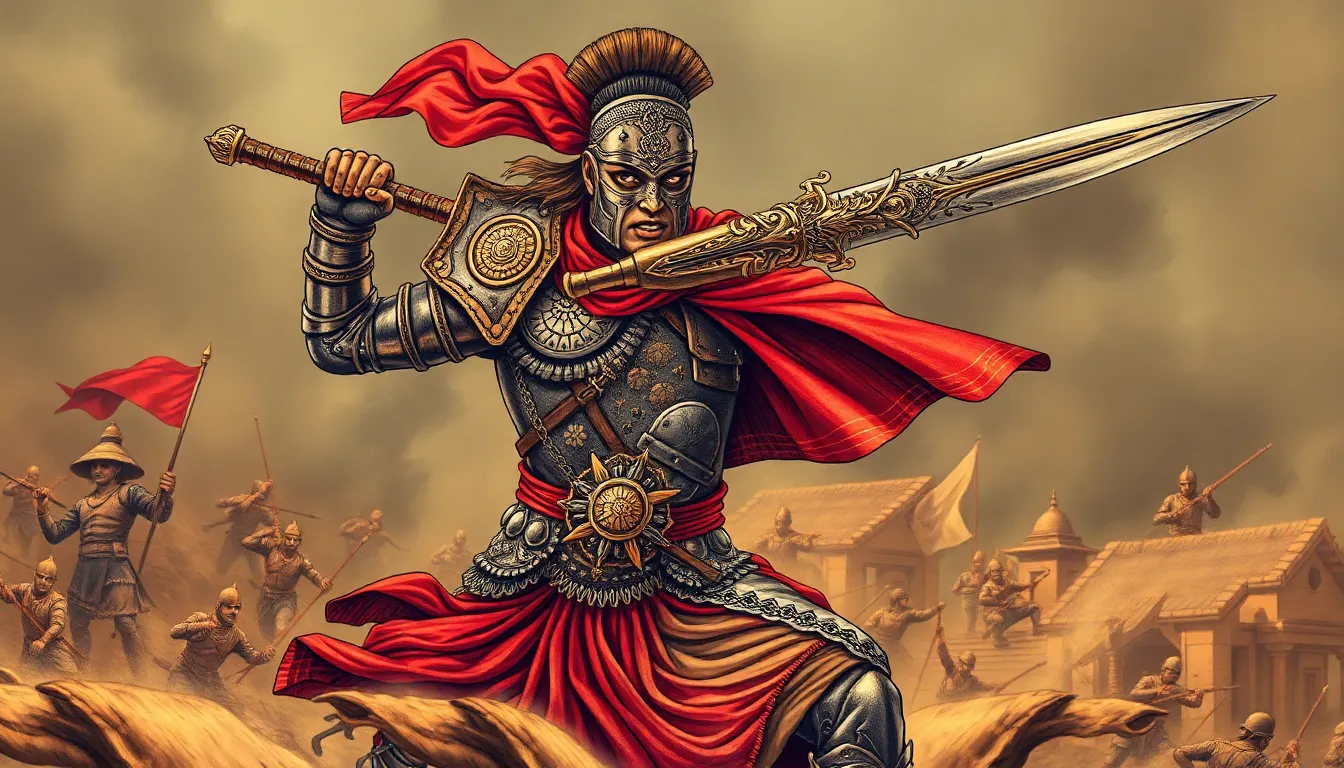
Warrior and historical figure tattoos capture the essence of India’s martial heritage through bold designs celebrating legendary leaders and their battles. These tattoos represent courage, honor, and cultural pride while showcasing the rich traditions of Indian warfare.
Shivaji and Maratha Warrior Designs
Chhatrapati Shivaji Maharaj tattoos dominate this category as the founder of the Maratha Empire symbolizes bravery and exceptional leadership. Artists frequently portray Shivaji in regal poses wearing traditional armor or battle-ready stances that emphasize his warrior spirit. Detailed facial sketches capture his determined expression while incorporating iconic symbols like the Rajmudra royal seal adds authenticity to the design.
Maratha warrior tattoos showcase ever-changing figures armed with curved swords or mounted on horses charging into battle. Movement and combat readiness define these designs through flowing capes, raised weapons, and fierce expressions that convey the warrior’s determination. Black and grey ink creates classic, bold aesthetics that suit masculine preferences while maintaining historical accuracy.
Popular placements include the chest, back, and upper arms where larger designs can fully display the intricate details of armor, weapons, and facial features. Many men choose to enhance these tattoos with Sanskrit quotes about valor or dates commemorating important Maratha victories.
Rajput King and Battle Scene Tattoos
Rajput king tattoos celebrate the chivalrous warrior ethos through designs featuring rulers in elaborate armor and traditional turbans. These tattoos often depict kings wielding swords and shields while maintaining dignified postures that reflect their noble status. Intricate details in the armor, jewelry, and weapons showcase the artistic skill required to capture the historical essence of Rajput royalty.
Battle scene tattoos bring epic clashes to life through groups of warriors engaged in combat across expansive compositions. Horses rear up on hind legs while riders brandish weapons, creating ever-changing movement that tells stories of honor and sacrifice. These designs reflect the Rajput code of valor through imagery of warriors choosing death over dishonor.
Artists spend considerable time researching historical accuracy to ensure authentic representations of Rajput military gear, architectural elements, and cultural symbols. Color palettes typically emphasize earth tones and metallic accents that enhance the medieval atmosphere while maintaining visual impact.
Ancient Indian Weapons and Armor
Traditional Indian weaponry tattoos feature talwar curved swords, ornate bows, arrows, and decorated shields that complement warrior themed designs. These weapons carry symbolic meaning beyond their practical purpose, representing protection, strength, and martial skill passed down through generations. Intricate engravings on sword hilts and shield surfaces provide opportunities for detailed artistic expression.
Armor motifs include chainmail patterns, ornate helmets, and chest plates that create striking visual elements when combined with warrior figures. These protective elements symbolize resilience and preparedness while honoring the craftsmanship of ancient Indian metalworkers. Layered armor designs create depth and texture that enhance the overall composition.
| Weapon Type | Symbolic Meaning | Popular Placement |
|---|---|---|
| Talwar Sword | Courage and Justice | Forearm, Thigh |
| Bow and Arrow | Precision and Focus | Shoulder, Back |
| Shield | Protection and Defense | Chest, Upper Arm |
| Chainmail | Resilience and Strength | Sleeve, Torso |
Modern interpretations often incorporate these weapon elements into larger narrative pieces that tell complete stories of ancient battles, heroic deeds, or personal transformation through warrior symbolism.
Modern Fusion Indian Tattoo Designs
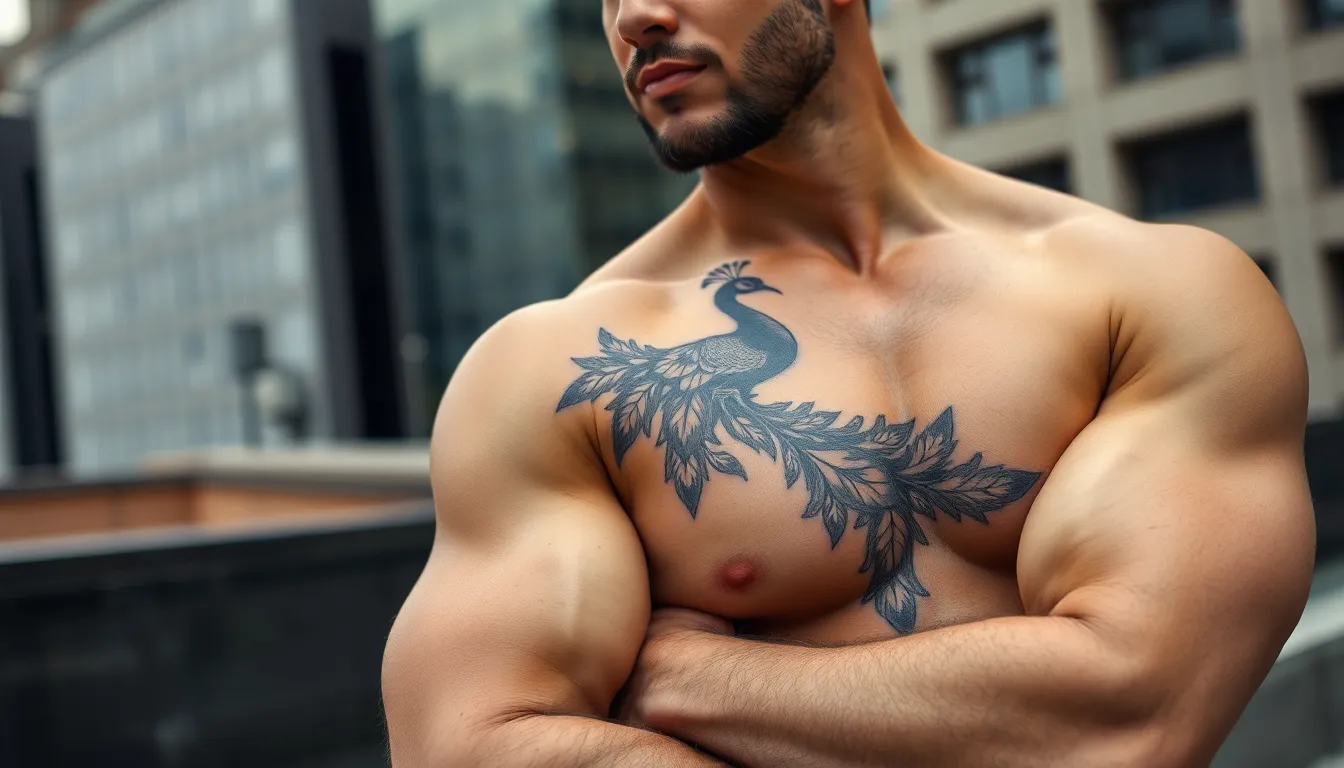
Modern fusion Indian tattoos represent the perfect marriage between ancient cultural traditions and contemporary artistic expression. These innovative designs allow men to honor their heritage while embracing cutting-edge tattoo artistry.
Contemporary Takes on Classical Motifs
Contemporary Indian tattoos breathe new life into timeless symbols through stylized line work and geometric abstraction. We’re seeing lotus flowers transformed with sharp angular petals, Om symbols enhanced with modern typography, and peacocks rendered in bold minimalist strokes. These designs respect traditional meanings while appealing to men seeking fresh visual narratives.
Classical elements like mandalas receive striking updates through fine line detailing and blackwork techniques. Artists merge different mythological elements to create unique compositions that tell personal stories. Sacred geometry patterns get reimagined with contemporary precision, offering spiritual significance wrapped in trendy aesthetics.
Deity imagery undergoes sophisticated transformations as artists blend realism with traditional iconography. Ganesha portraits feature photorealistic details combined with ornate traditional patterns, while Shiva representations incorporate modern shading techniques. These fusion approaches maintain cultural authenticity while satisfying contemporary artistic preferences.
Minimalist Indian Symbol Tattoos
Minimalist Indian tattoos focus on singular meaningful symbols rendered with clean lines and minimal shading. We recommend Om symbols for wrists or fingers, offering spiritual connection without overwhelming visual impact. These designs cater to men who prefer subtle cultural expression over elaborate artwork.
Trishul tattoos work perfectly as small, discreet pieces behind the ear or on the neck. Simple mandala designs featuring basic geometric patterns appeal to those seeking spiritual balance through understated artistry. Each symbol carries profound meaning while maintaining contemporary simplicity.
Small Sanskrit characters or brief mantras create powerful statements through minimal execution. These tattoos prove that cultural significance doesn’t require extensive coverage or complex detailing. Single-line interpretations of traditional motifs offer maximum impact through refined simplicity.
Abstract Interpretations of Traditional Art
Abstract Indian tattoos draw inspiration from traditional art forms like Warli and Madhubani while embracing modern artistic freedom. Artists use fragmented shapes and asymmetrical compositions to transform cultural symbols into contemporary masterpieces. Negative space becomes a crucial design element, creating visual breathing room within complex traditional patterns.
Warli art translates beautifully into abstract tattoo form through simplified geometric shapes and tribal storytelling elements. These designs capture the essence of village life and nature through minimalist interpretation. Artists fragment traditional scenes into modern artistic expressions that resonate on both personal and cultural levels.
Madhubani patterns receive abstract treatment through deconstructed motifs and contemporary color theory. Traditional bird and fish symbols become flowing, organic shapes that maintain cultural connection while embracing artistic innovation. This approach allows for creative freedom while honoring ancestral artistic traditions.
Placement Ideas for Indian Tattoo Designs on Men
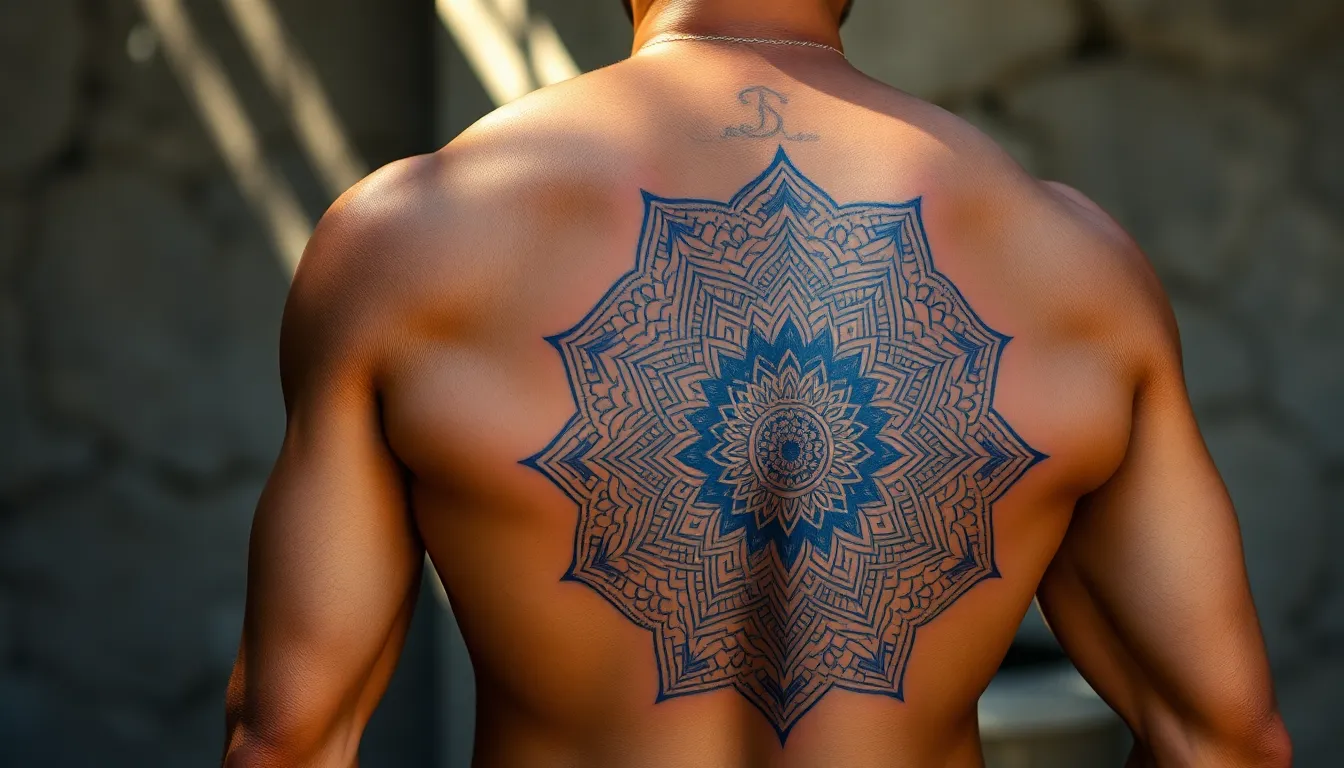
Selecting the right placement for your Indian tattoo design significantly impacts both its visual appeal and personal meaning. Different body areas accommodate various design sizes and complexities while maintaining the cultural integrity of these powerful symbols.
Chest and Back Pieces for Large Designs
Expansive canvases like the chest and back accommodate the most intricate Indian tattoo designs, allowing artists to capture every detail of complex spiritual motifs. These placements showcase full deity portraits of Ganesha or Shiva, elaborate mandala patterns, and comprehensive tribal art pieces that tell complete cultural stories.
Centered chest tattoos create striking focal points for sacred symbols, while designs that spread across the pectorals and shoulders provide ever-changing visual flow. Back pieces offer even more space for detailed compositions, supporting multiple elements like sacred geometry combined with traditional tribal patterns.
Large back tattoos can incorporate flowing designs that move naturally with the body’s contours, creating visually powerful statements about spiritual beliefs and cultural heritage. Artists often use these areas to combine various Indian symbols into cohesive masterpieces that represent personal transformation journeys.
| Placement | Design Capacity | Popular Indian Motifs |
|---|---|---|
| Full Back | Highly detailed | Complete deity scenes, elaborate mandalas |
| Upper Chest | Medium to large | Sacred symbols, spiritual icons |
| Full Chest | Complex designs | Tribal patterns, cultural narratives |
Arm and Shoulder Placements for Medium Tattoos
Upper arms and shoulders provide ideal locations for medium sized Indian tattoo designs, offering natural curvature that complements circular motifs like mandalas and chakra symbols. These areas maintain excellent visibility while allowing for professional discretion when needed.
Shoulder placements work exceptionally well for deity symbols and tribal bands, taking advantage of the muscle’s natural shape to enhance the tattoo’s three dimensional appearance. Artists frequently choose these locations for Om symbols and spiritual icons that require moderate detail without overwhelming the space.
Versatile arm tattoos can function as standalone pieces or integrate into larger sleeve designs, maintaining clarity and cultural significance over time. The upper arm’s skin quality helps preserve the sharpness of intricate line work found in traditional Indian patterns.
Natural muscle contours in these areas enhance the visual impact of Sanskrit mantras and geometric patterns, creating ever-changing effects as the body moves. These placements balance cultural expression with practical considerations for various lifestyle needs.
Wrist and Finger Options for Small Symbols
Minimalist placements on wrists and fingers suit smaller Indian tattoos perfectly, transforming powerful symbols like Om, small mandalas, and single line tribal motifs into personal spiritual reminders. These locations offer intimate connections to meaningful cultural symbols while maintaining professional appropriateness.
Wrist tattoos provide subtle yet important ways to carry spiritual insignia, with designs easily shown or concealed based on personal preference or professional requirements. Popular choices include simplified Om symbols and geometric patterns that maintain their cultural meaning even though size constraints.
Finger placements accommodate single symbolic elements like small Sanskrit characters or minimalist mandala designs, creating personal talismans that accompany daily activities. These tattoos serve as constant reminders of spiritual beliefs and cultural connections.
Strategic positioning on these areas allows for layering multiple small symbols across different fingers or both wrists, creating cohesive collections of meaningful Indian motifs. Artists often recommend these placements for first time tattoo recipients exploring Indian cultural designs.
Conclusion
Indian tattoo designs offer men an extraordinary opportunity to wear their cultural appreciation and spiritual beliefs with pride. We’ve explored how these powerful symbols transcend mere decoration to become meaningful expressions of strength wisdom and personal transformation.
From sacred mantras and deity portraits to wildlife motifs and warrior imagery these designs connect modern men to India’s rich heritage. Whether you choose a minimalist Om symbol or an elaborate mandala the key lies in selecting artwork that resonates with your personal journey.
We encourage you to work with experienced tattoo artists who understand the cultural significance behind these designs. This ensures your Indian tattoo becomes not just stunning body art but a respectful tribute to one of the industry’s most spiritually profound traditions.
Frequently Asked Questions
What makes Indian tattoo designs popular among men?
Indian tattoo designs combine spiritual symbolism with bold masculine aesthetics. They feature meaningful elements like mandalas, Hindu deities, and Sanskrit text that represent strength, wisdom, and personal transformation. These tattoos go beyond decoration, serving as powerful symbols of cultural heritage and spiritual connection that resonate with modern men seeking meaningful body art.
Which Hindu deity tattoos are most popular for men?
Ganesha tattoos are extremely popular, symbolizing new beginnings and obstacle removal. Shiva tattoos represent transformation and strength, often featuring the Nataraja pose or trident symbol. Hanuman tattoos embody courage and devotion, showcasing the monkey deity’s legendary strength. These designs typically feature elaborate details and are commonly placed on chest, arms, or shoulders.
What do Sanskrit and mantra tattoos represent?
Sanskrit and mantra tattoos fuse spiritual depth with masculine artistry. Om tattoos transform the universe’s primordial sound into visual art, while sacred mantras like “Har Har Mahadev” represent transformation and protection. These designs offer timeless elegance and can range from minimalist finger placements to elaborate chest pieces, serving as constant spiritual reminders.
How do mandala tattoos appeal to men?
Mandala tattoos represent the universe through symmetrical patterns, appealing to men seeking spiritual balance and personal equilibrium. These intricate designs reflect the complexity of universal connection and often incorporate yantra symbols for spiritual energy focus. They symbolize unity and offer a meditative quality that attracts men valuing both artistic beauty and spiritual significance.
What Indian wildlife tattoos are popular among men?
Tiger tattoos symbolize power and courage, featuring intricate jungle elements and Sanskrit mantras. Elephant tattoos represent wisdom and loyalty with ornate cultural details. Peacock feather tattoos showcase vibrant colors and spiritual symbolism. These wildlife designs connect masculinity with spirituality, often incorporating traditional Indian artistic elements for enhanced cultural significance.
What are modern fusion Indian tattoo designs?
Modern fusion designs blend ancient cultural traditions with contemporary artistry. They include stylized line work, geometric abstraction of classical motifs, and minimalist interpretations of traditional symbols. These designs maintain cultural essence while appealing to modern aesthetics, offering subtle cultural expression through clean lines and abstract interpretations of Warli, Madhubani, and other traditional art forms.
Where should Indian tattoos be placed on men?
Larger designs like deity portraits and elaborate mandalas work best on chest and back areas. Medium-sized tattoos are ideal for upper arms and shoulders, providing good visibility and space for detail. Smaller minimalist symbols suit wrists and fingers for intimate cultural connections. Placement should enhance both visual appeal and personal meaning of the design.
What regional Indian art styles work well as tattoos?
Madhubani tattoos from Bihar feature intricate line work and vibrant motifs. Warli tattoos from Maharashtra embrace minimalist geometric shapes. Rajasthani miniature tattoos reflect opulent court traditions with elaborate designs. These regional styles maintain deep cultural significance while transforming traditional art forms into powerful tattoo expressions that celebrate India’s diverse artistic heritage.
